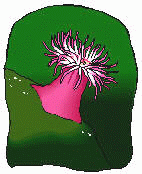|
Stromatolites are layered mounds, columns, and sheets found in the rock. They were originally formed by the growth of layer upon layer of cyanobacteria, a single-celled photosynthesizing microbe growing on a sea floor. Cyanobacteria are prokaryotic cells (the simplest form of modern carbon-based life) which lack a DNA-packaging nucleus. This simple organism would be the only life on Earth for the next 2 billion years.
|

|
Very rarely, stromatolites are still forming today in places such as Shark Bay, Australia. The salinity of the water is very high in this bay, and basically the only life that can survive is cyanobacteria. Under normal ocean conditions, the cyanobacteria would be eaten by marine creatures such as snails. In this special case however, columns and mounds are forming as can be seen in the picture to the left.
|
The first multi-celled animals (metazoa) evolved over 600 million years ago.
Primitive metazoa can be grouped in three basic categories: sponge-like animals, cnidarians, and worms. The sponges, and cnidarians (corals and sea anemones), are the most primitive with about 11 specialized cell types. Worms and higher metazoa have approximately 55 specialized cells.
|

|
Sponges
Sponges are the simplest grade of multi-celled animals. In general, sponges have open-topped, sack-like bodies which are fixed to the sea floor. Water is pulled through the body, and food is filtered out. Sponge image courtesy of Smithsonian Institute
|
|
|
Cnidarians
The cnidarians include corals, sea anemones, and jellyfish.Their basic body plan is also a sack-like form, but at one end there is a mouth which can be opened and closed, and tentacles which direct food to the mouth.
|
|

|
Worms
Worms are the most advanced grade of simple metazoan, and it is this body plan from which all higher animals evolved. Worms have a fluid-filled cavity called a coelom inside the body and variations of this cavity can be seen in all higher animals. In many animals, it has become the sack which holds the internal organs.
|
|


Linux Space Programs

Astronomy Clubs
|